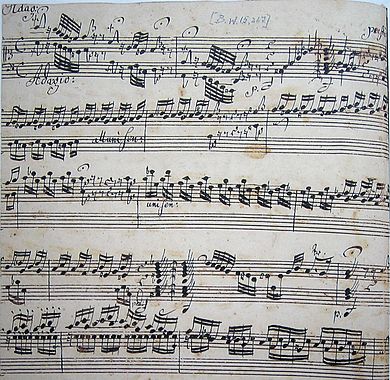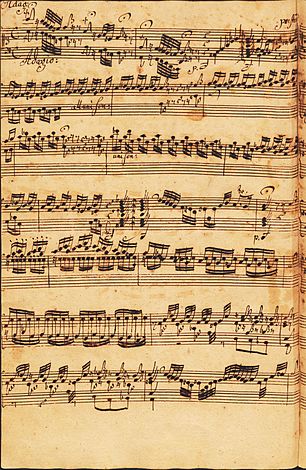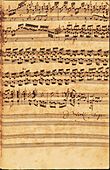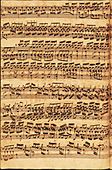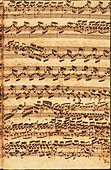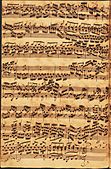Toccata and Fugue in D minor, BWV 565 facts for kids
The Toccata and Fugue in D minor, known as BWV 565, is a famous piece of organ music. Many people believe it was written by the great composer Johann Sebastian Bach (1685–1750). The music starts with a lively section called a toccata. Then comes a fugue, which is like a musical chase where different parts play the same tune. The piece finishes with a short ending part called a coda.
Experts aren't sure exactly when Bach wrote this piece. Some think it could have been around 1704. Others suggest it might have been much later, even in the 1750s. The music has a style typical of the north German organ school from the Baroque era. However, it also includes influences from other styles, like those found in south German music.
For about 100 years, the only way this music survived was through a handwritten copy made by Johannes Ringk. The piece was first printed in 1833, thanks to Felix Mendelssohn. He also played it in a very popular concert in 1840. Later, a piano version by Carl Tausig helped more people discover it. But it wasn't until the 1900s that it became more popular than Bach's other organ works. Its fame grew even more after it was used in Walt Disney's movie Fantasia (in an orchestral version by Leopold Stokowski). Today, it is by far the most well-known organ piece from the 1700s.
Many different ideas have been shared about this piece. Some say it's like "program music" that tells a story, perhaps describing a storm. But in Disney's Fantasia, it was presented as "absolute music"—music that doesn't tell a story but is enjoyed for its own beauty. In the late 1900s, some experts like Peter Williams and Rolf Dietrich Claus questioned if Bach really wrote it. Other Bach scholars, like Christoph Wolff, believe it was indeed written by Bach. Some people just enjoy the music and don't worry about who wrote it.
Contents
The Music's Journey Through Time
The oldest copy of BWV 565 that we still have was made by Johannes Ringk. This copy doesn't have a date. The Berlin State Library, where the manuscript is kept, says Ringk made his copy between 1740 and 1760. Ringk was a student of Johann Peter Kellner, who used to be Bach's student. Ringk likely copied the music exactly as his teacher gave it to him.
Ringk's copy has some small mistakes, like notes not adding up correctly in a measure. These errors might show that Kellner, who copied many of Bach's works, was sometimes a bit careless.
How the Music Was Written Down
The title page of Ringk's copy calls the piece Toccata con Fuga (Toccata with Fugue). It names Johann Sebastian Bach as the composer. It also says the music is in "D minor." However, Ringk's copy doesn't have the usual flat symbol for D minor. Instead, it's written in a way that looks like the D Dorian mode.
There was another Bach piece also called Toccata and Fugue in D minor (BWV 538). That one was given the nickname "Dorian" to tell it apart from BWV 565. Most modern printed versions of BWV 565 use the regular D minor key signature, unlike Ringk's original copy.
- Ringk manuscript
Ringk's copy doesn't have a separate line of music for the organ's foot pedals. This was common in the 1700s. Modern printed versions always show the pedal part on its own line.
Later copies of the music, made in the 1800s, have similar ways of fixing the errors in Ringk's copy. These later copies use the modern way of writing music, with a separate line for the pedals. They also have fewer of the special musical marks (like fermatas) that Ringk used a lot.
The name "Toccata" was probably added later. In Bach's time, these organ pieces were often just called "Prelude" or "Prelude and Fugue."
Musical Styles in the Piece
German organ music in the 1600s and 1700s had two main styles: north German (like Dieterich Buxtehude) and south German (like Johann Pachelbel). This Toccata and Fugue has parts that sound like both! It has the exciting, free style of north German music. But it also has parts that sound like a "recitative," which is more common in south German music.
A small part of the fugue in BWV 565 is actually an exact copy of a phrase from one of Pachelbel's pieces. It was normal back then for composers to use themes from other composers' works to create new fugues.
What the Music Sounds Like
BWV 565 follows a common structure for north German organ music. It starts with a free, improvisational part (the toccata), then a section with a main tune that is repeated and layered (the fugue), and finally a short, free ending.
The Toccata: A Daring Start
The Toccata begins with a single, fast musical line played high on the keyboard. It then quickly moves down to the lower notes. Here, a special chord appears, built one note at a time, which then smoothly leads to a D major chord.
Three short musical parts follow, each repeating a small tune. The section ends with another special chord that leads back to D minor. The second part of the Toccata has many different musical patterns. The organ's foot pedals switch to a different key, A minor. This leads into the third part of the Toccata. This last part mostly repeats the same three-note pattern. After a quick flourish from the pedals, the piece ends with a D minor chord.
The Fugue: A Musical Conversation
The main tune, or "subject," of the four-voice fugue is made up of fast sixteenth notes. It sounds like a violin tune, first falling, then rising. This kind of tune was common in Baroque music.
Usually, the "answer" (when the tune is repeated by another voice) is in the "dominant" key. But here, it's in the "subdominant" key, which is unusual. Even though it's called a four-part fugue, most of the time you only hear three voices playing. Sometimes, there are only two, or even one voice.
The fugue mostly uses simple chords. But there's a surprising moment when the main tune appears in C minor. Also, the organ pedals play the main tune all by themselves, which is very rare for a Baroque fugue! Right after the last time the main tune is played, the fugue ends on a long-held B-flat major chord.
The Coda: The Grand Finale
A multi-part ending, called a coda, follows. It's marked Recitativo, meaning it should sound like someone speaking. Even though it's only 17 measures long, it changes speed five times! The last few measures are played Molto adagio (very slowly). The piece finishes with a D minor chord that sounds like a peaceful ending.
How Long Does It Take to Play?
This piece usually takes about nine minutes to perform. Some performances are a bit shorter (around 8 minutes, 15 seconds), while others can be longer (over 10 minutes, 30 seconds). The first part, the Toccata, usually takes less than a third of the total time.
Composers in the 1600s and 1700s often didn't write down exactly which sounds (or "registration") an organist should use. So, performers can choose how to play it. Some use a simple, full organ sound, while others use very complex combinations of sounds.
Images for kids
See also
 In Spanish: Tocata y fuga en re menor, BWV 565 para niños
In Spanish: Tocata y fuga en re menor, BWV 565 para niños


